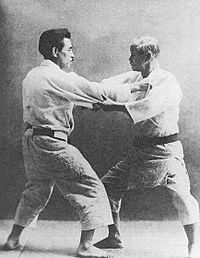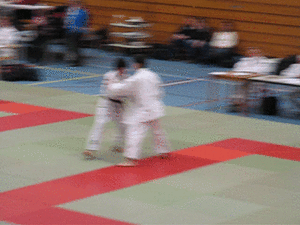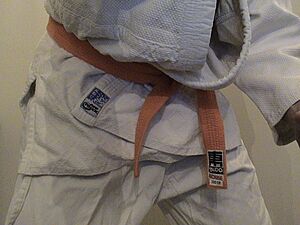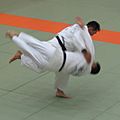Judo facts for kids
 |
|
|---|---|

Kyuzo Mifune (left) and Kanō Jigorō (right)
|
|
| Focus | Grappling |
| Hardness | Full contact |
| Country of origin | |
| Creator | Kanō Jigorō |
| Parenthood | Various koryū jujutsu schools, principally Tenjin Shin'yō-ryū and Kitō-ryū |
| Descendant arts | Bartitsu, Brazilian jiu-jitsu, Hapkido, Kosen judo, Krav Maga, Kūdō, Modern arnis, Sambo,Shoot wrestling, Submission wrestling, Vale tudo |
| Olympic sport | Since 1964 (men) and 1992 (women) |
| Official website | International Judo Federation (IJF) The Kodokan |
Judo is a cool martial art from Japan. It's also a combat sport and has been an Olympic sport since 1964! It's known as a type of jacket wrestling.
Judo was created in 1882 by a man named Kanō Jigorō. Someone who practices Judo is called a "judoka" (柔道家, jūdōka). The special uniform they wear is called a "judogi" (柔道着, jūdōgi).
In competitive Judo, the main goal is to throw your opponent to the ground. You can also try to hold them down with a pin. Another way to win is by using a joint lock or a choke to make them give up. While some Judo forms include strikes, these are not allowed in competitions. The main group that organizes Judo worldwide is the International Judo Federation.
Judo has two important ideas behind it. The first is "Seiryoku-Zenyo," which means 'using your energy wisely.' The second is "Jita-Kyoei," meaning 'helping each other and working together.' Judo has also inspired many other martial arts around the world, like Brazilian jiu-jitsu and Sambo. It has even influenced styles like mixed martial arts (MMA).
Contents
Learning and Ranking in Judo
Judo has a special system to show how much a judoka has learned. This system was created by Jigoro Kano himself. As you learn more, you move up through different levels.
Your level in Judo is shown by the color of your belt. When you start, you usually wear a white belt. As you get better, you earn different colored belts. Once you reach a very high level, you get to wear a black belt. This belt system is now used in many other modern martial arts too!
Your Judo Uniform (Judogi)
Judo students wear special white uniforms called jūdōgi (柔道着, judogi). Sometimes people just call it a "gi." This uniform has three main parts:
- A strong cotton jacket, like a kimono, called an uwagi (上衣, jacket).
- A belt, called an obi (帯, obi, belt), which shows your rank with its color.
- Cotton pants with a drawstring, called zubon (ズボン, trousers).
The judogi is made from tough fabric. This helps it last through all the pulling, throwing, and grappling in Judo practice.
For big competitions, one judoka wears a white judogi and the other wears a blue one. This makes it easy for judges, referees, and people watching to tell them apart. In Japan, both judoka often wear white, and one might have a red belt to show who's who.
If you compete in events organized by the International Judo Federation, your judogi needs to have a special label. This label means the uniform has been checked to make sure it's made correctly. This ensures it's fair for both players to grip and perform techniques.
World Judo Day
Every year on October 28, people who love Judo celebrate World Judo Day. This day honors the birthday of Judo's founder, Jigoro Kano. Each year has a different theme, but the main goal is always to highlight the good values that Judo teaches. The first World Judo Day was celebrated in 2011.
Related pages
Images for kids
-
Kanō Jigorō and Yamashita Yoshitsugu performing Koshiki-no-kata
-
International judo camp in Artjärvi, Orimattila, Finland
See also
 In Spanish: Judo para niños
In Spanish: Judo para niños













